Every creator wants their videos to be seen by as many people as possible.
And video SEO is one way to achieve that.
This guide explains what it is and how to go about it.
What Is Video SEO?
Video SEO is all about reaching a wider audience and getting more video views from search engines like Google.
It involves optimizing your video content so it ranks highly when people search for the topic your video covers.
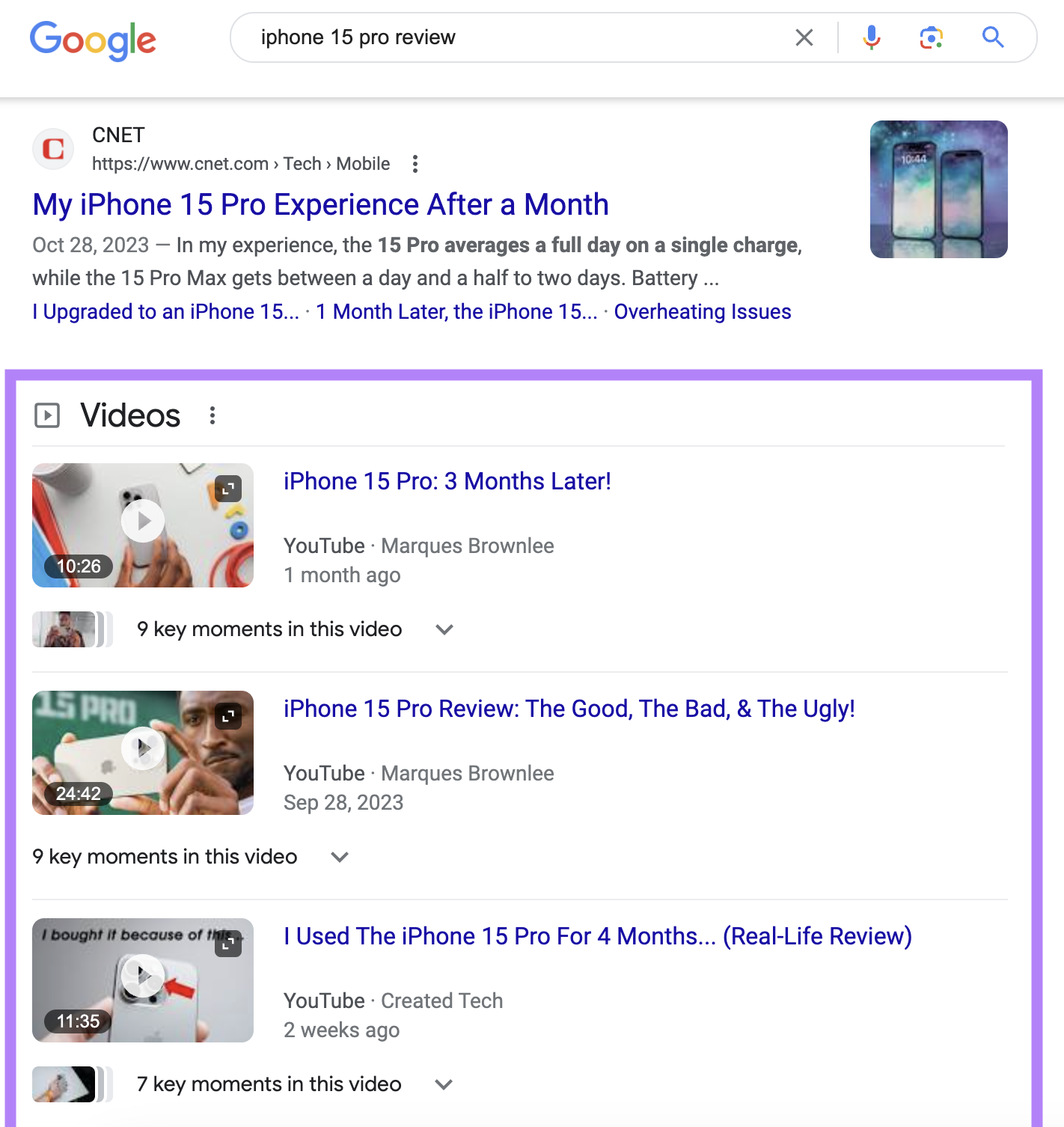
This ensures viewers click your video instead of competitors’ videos.
Done right, it leads to growth in views, subscribers, and website visitors (if you have a website).
But how do you get your videos to rank on Google? And what are the best practices to follow?
Let’s find out.
9 Video SEO Tips to Help Your Videos Rank
Ranking your videos on Google boils down to nine simple steps. Let’s go through them one by one.
1. Make Videos About Topics People Are Searching For
If nobody is searching for the topic your video covers, then it won’t get many views from Google. Even if it ranks high.
That’s why it’s so important to focus on topics people are interested in.
But how do you find these topics?
Semrush’s Keyword Magic Tool can help.
Let’s say you review and unbox tech products. Start by entering broad keywords like “unboxing” or “review” in the tool.

In this case, the tool will return all the popular search terms that contain the word “review.” Or some close variation.

Looking at these keywords, they all seem unrelated to tech.
So we need to narrow things down.
What do you review? Maybe smartphones, laptops, or game consoles?
When people search for reviews, they usually search for videos of a specific product from a particular brand.
For example, “iphone 15 pro review.”
So, let’s focus our results by applying a filter to show product- or brand-specific keywords.
You can do this by clicking the “Include keywords” drop-down, selecting the circle next to “Any keywords,” and adding relevant brand or product names.
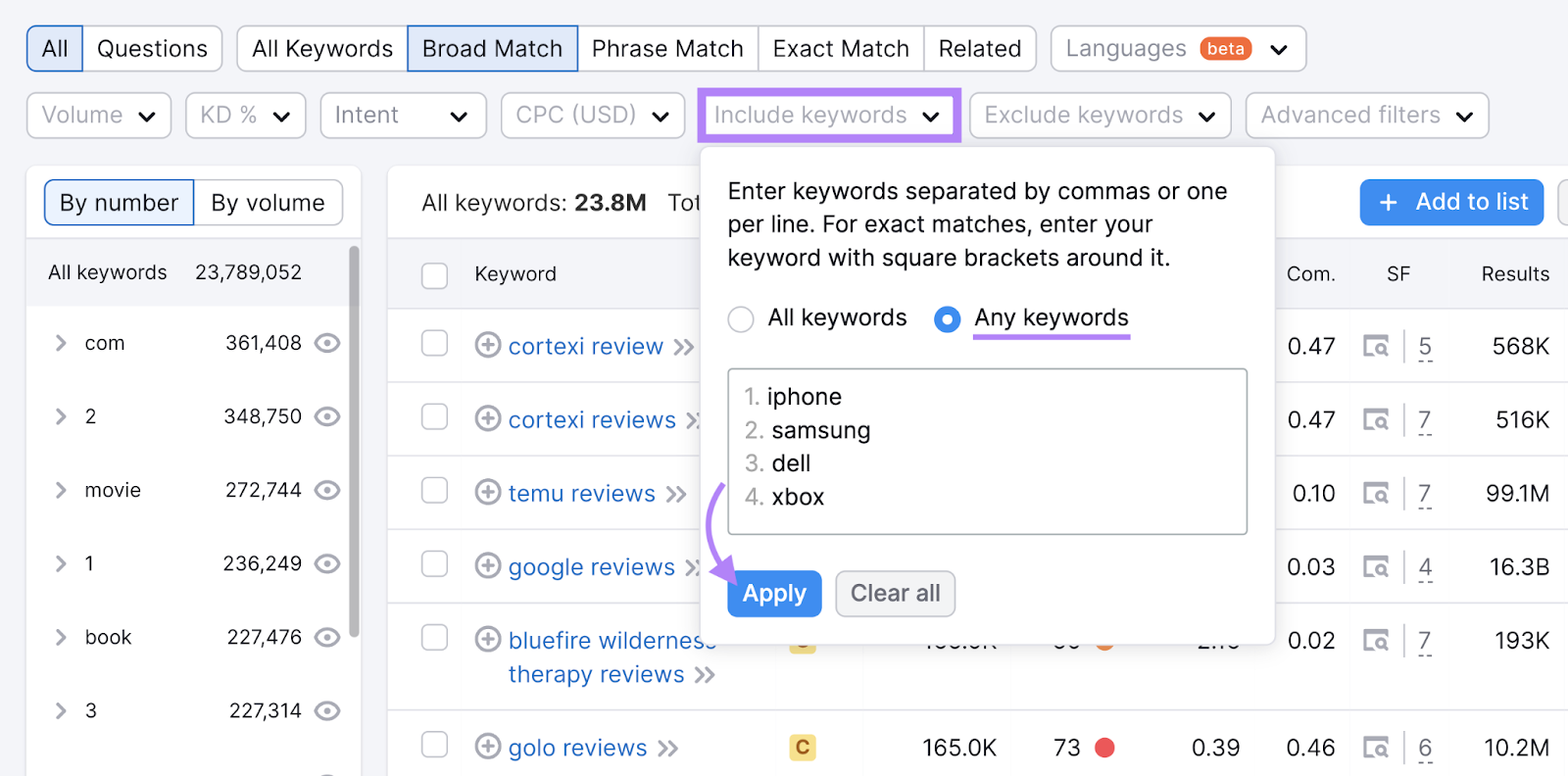
And you’ll see a large pool of topic ideas for your videos.
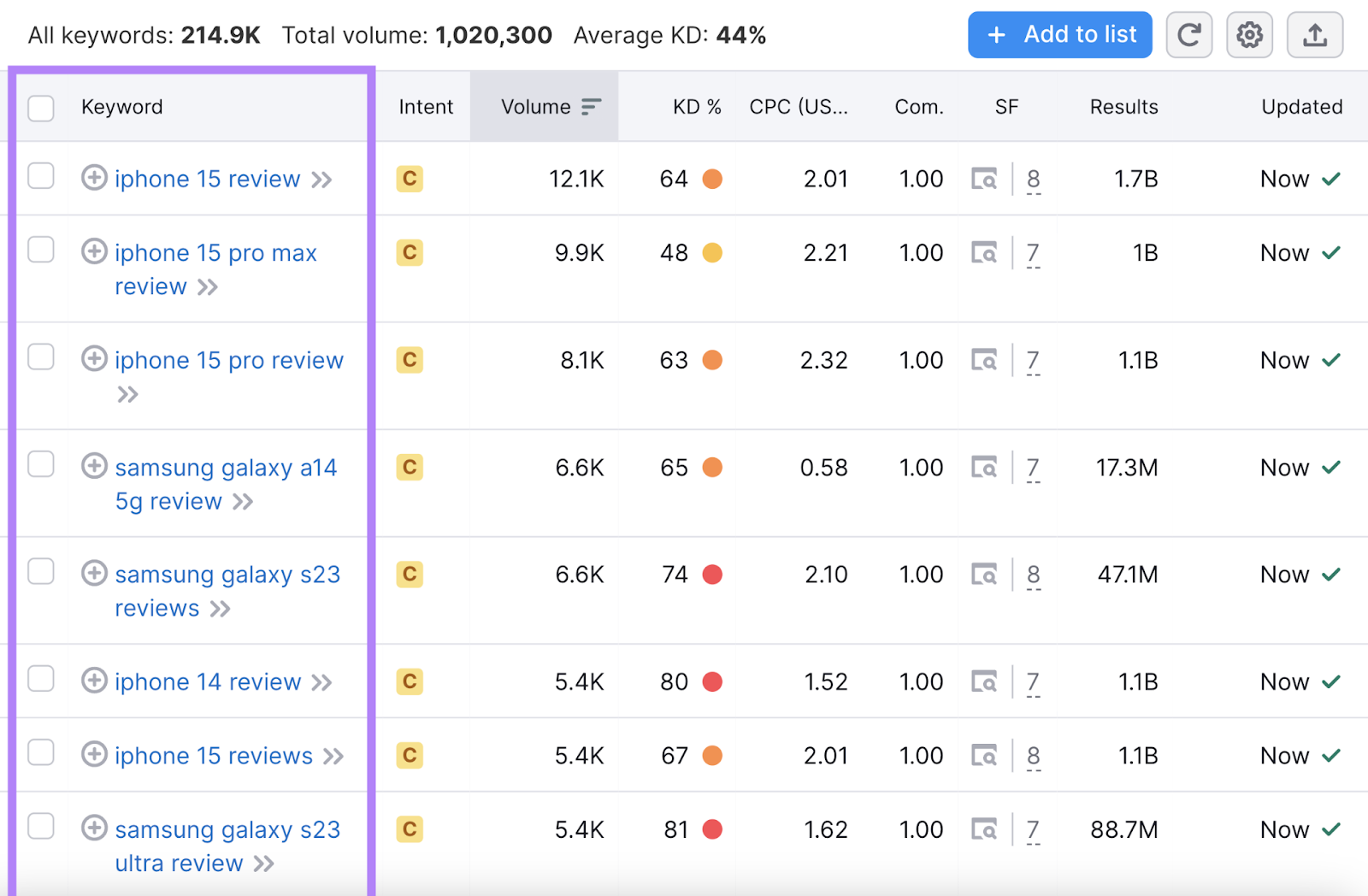
But these topics aren’t fully qualified yet.
For a topic to make sense for a video, it must have clear "video intent"—i.e., people want to watch a video around your topic.
If the topic doesn’t have video intent, that means your video won’t rank in search results. No matter how hard you try.
Normally, Google will just show traditional plain “blue link” results.
But if your topic has a video intent, it’ll show a special “Videos” section in search results. Like this:
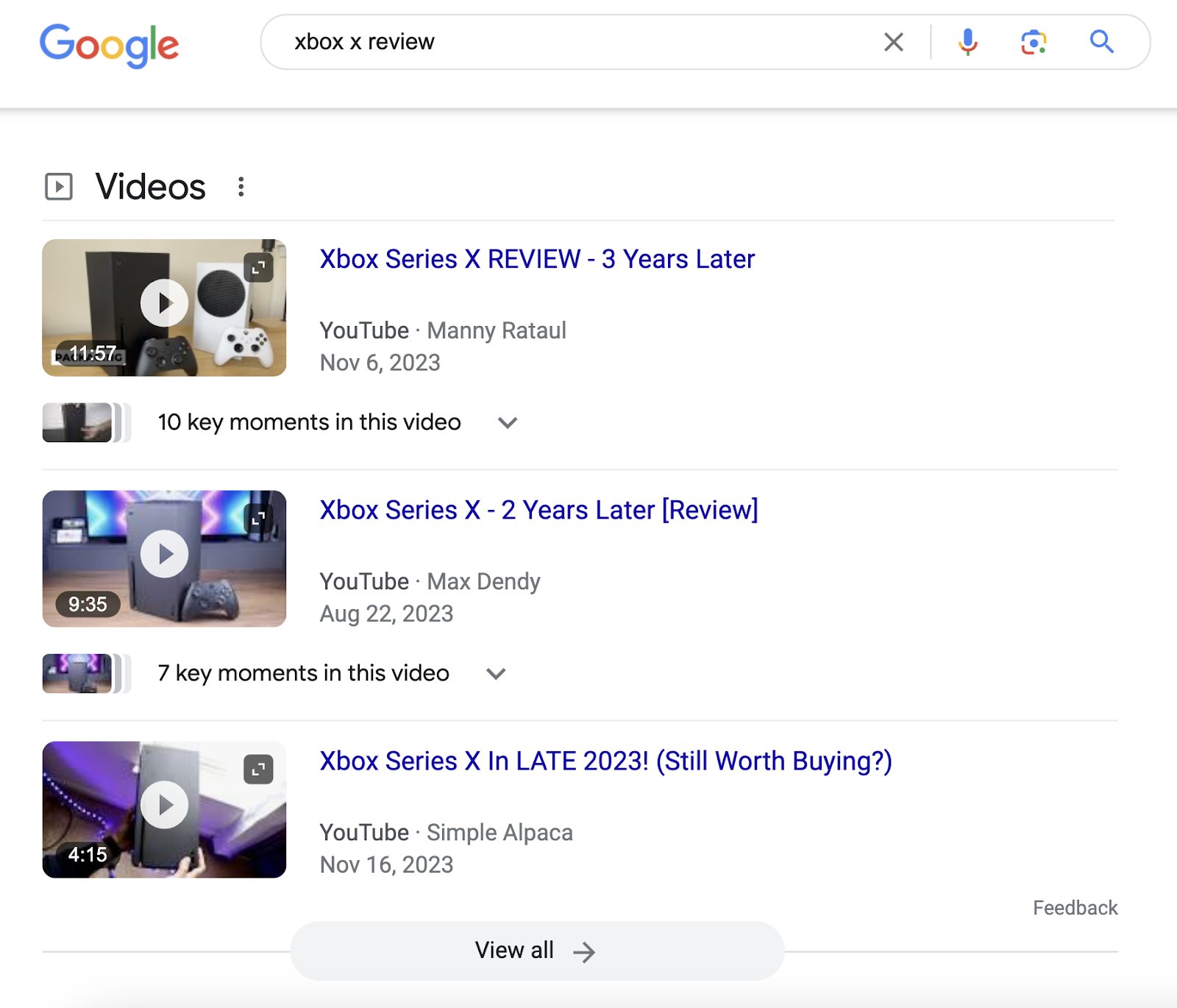
The Keyword Magic Tool can help you further narrow your list to only show topics where videos appear in search results.
Just toggle these options under “SERP features” in the “Advanced filters” drop-down:
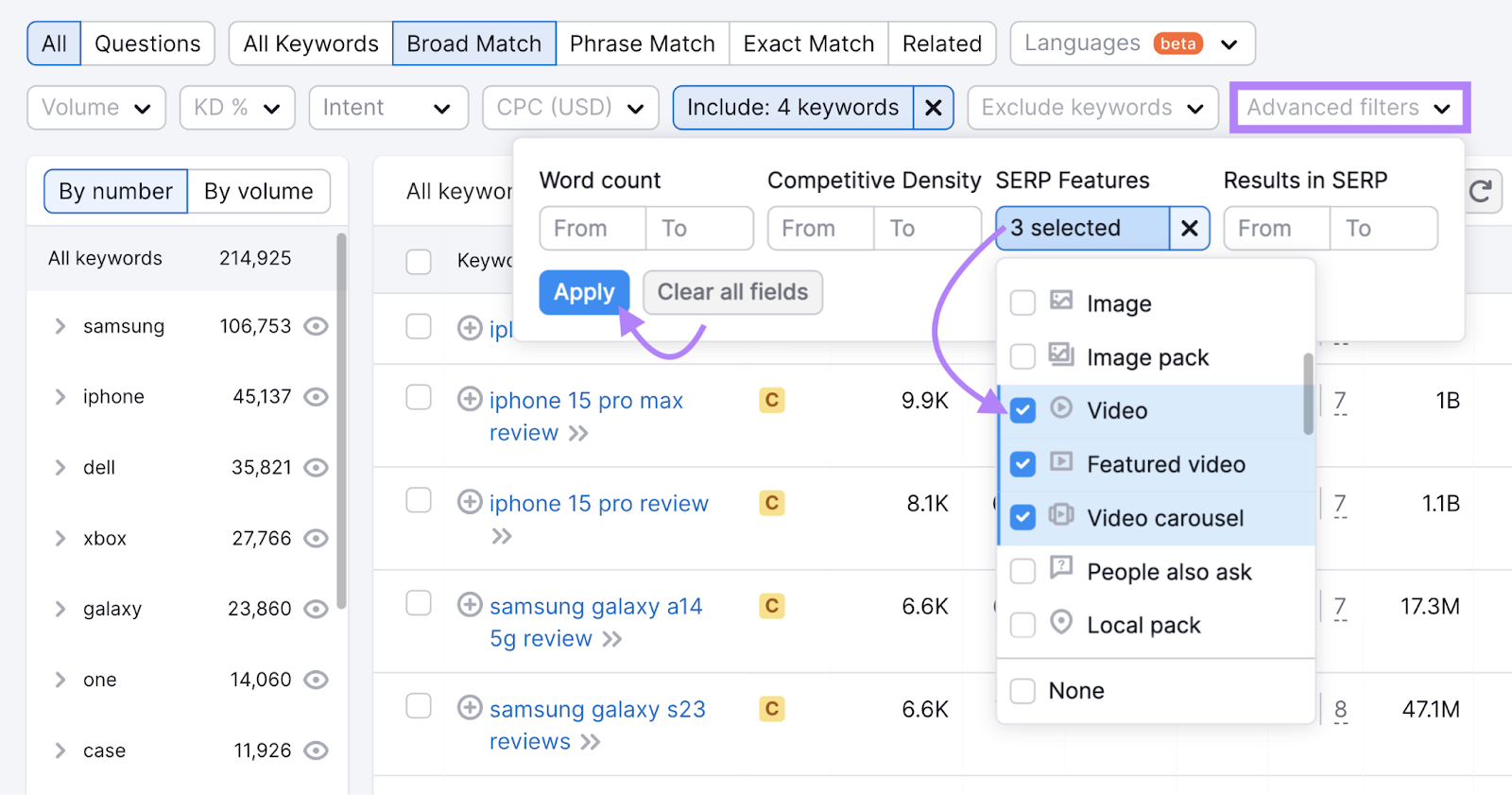
You’ll now be left with topics you should definitely cover.
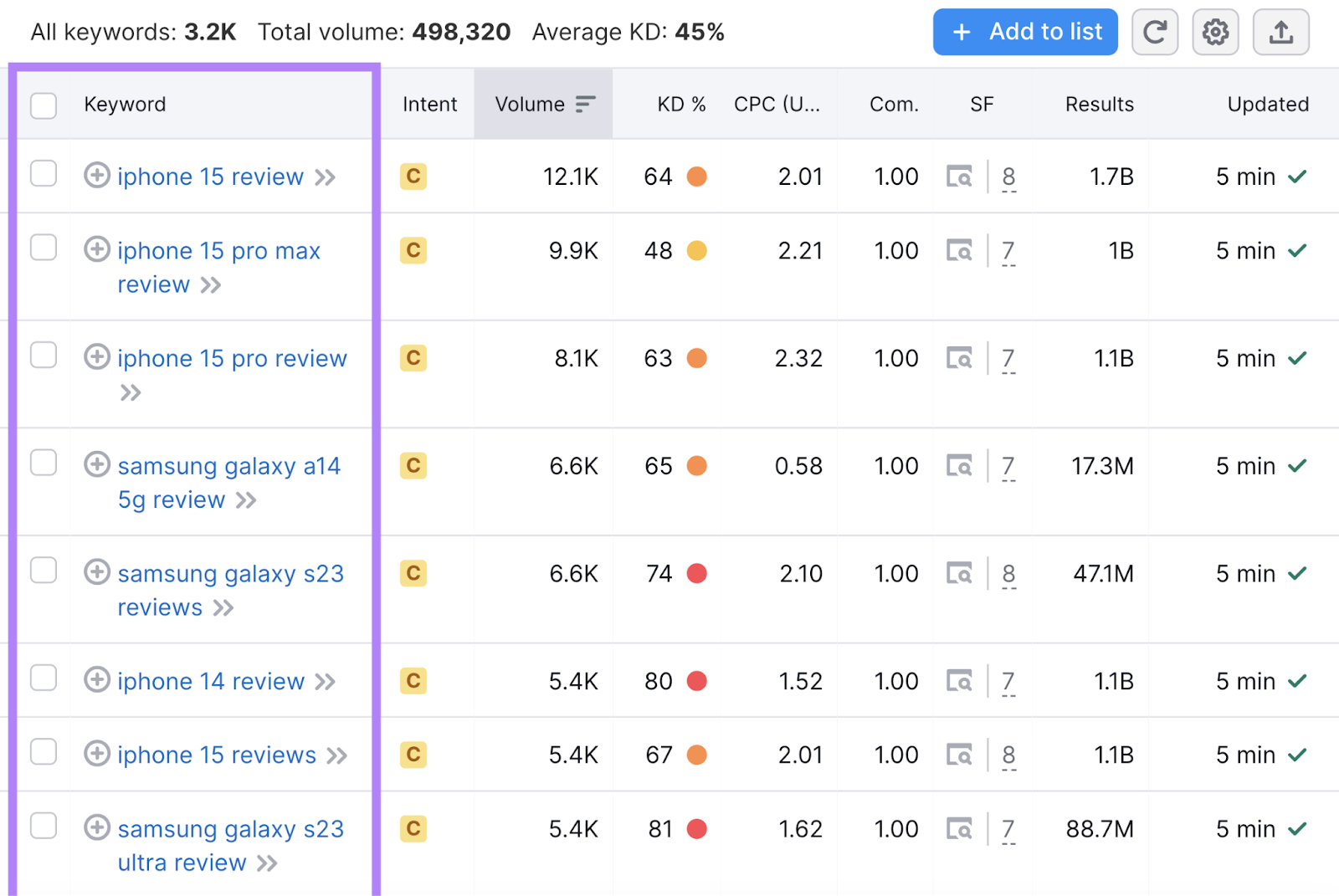
2. Make High-Quality Videos
Google ranks content that’s high quality.
What does “high quality” mean?
There’s no definitive answer to this. And the exact recipe for creating a high-quality video varies from niche to niche.
For example, a tech reviewer should focus on in-depth analyses. While a fitness influencer should focus on showcasing proper form and technique.
But there are some common characteristics high-quality videos tend to have.
First, their intros capture attention right away—in the first 15-20 seconds. So viewers are more likely to stay for the full video.
Second, high-quality videos provide value. By educating, entertaining, inspiring, and/or helping people in some way.
And third, they meet certain production quality standards. Things like good camerawork, audio, lighting, editing, and overall technical execution matter a lot.
They make videos more immersive and enjoyable to watch.
If you’re interested in learning more about creating high-quality videos your audience wants to watch, check out our YouTube video on creating engaging videos.
3. Optimize Your Videos’ Titles
Your video’s title (which you add when uploading to YouTube or another hosting platform) appears alongside your video in the search results.
Like this:

Or specifically in the “Videos” section:
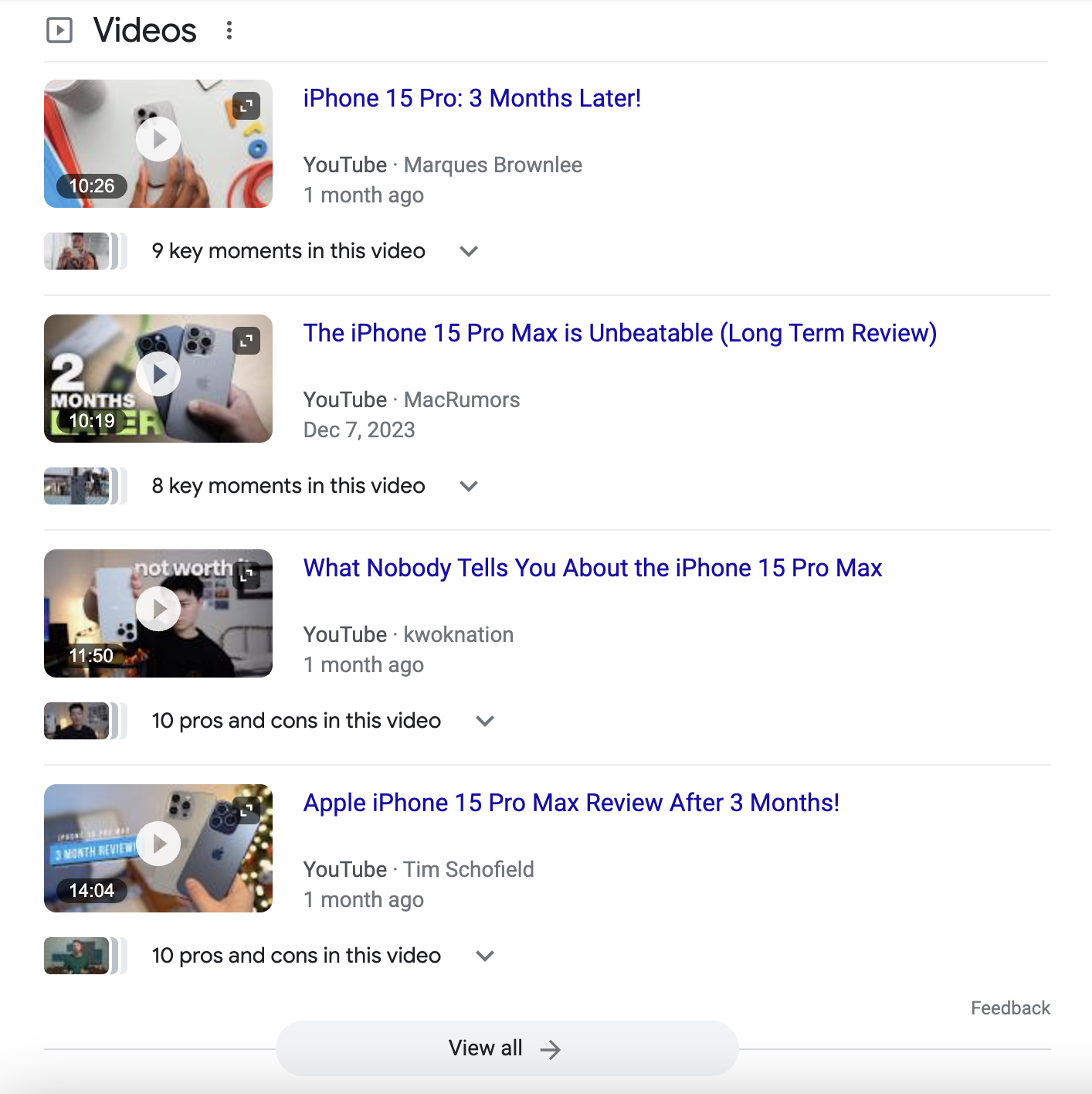
Google looks at the title of your video to understand what topic your video covers. So, include your main keyword naturally in the title.
Now, if someone searches for that keyword (and it has video intent), Google is more likely to show your video in the search results.
Also, keep your title under 60 characters. Because Google truncates titles that are too long.
Titles also present the opportunity to improve the click-through rate (CTR) for your videos. And more clicks translate to more views.
How do you write titles that attract more clicks?
Ask a question or include numbers if relevant. Like "10 Tips for..." or "5 Must-Have Tools..."
More people are likely to click on titles like these.
4. Optimize Your Video Descriptions
The description you add when you upload your video can influence whether people click on it if it appears in search results.

How can you optimize your video description for CTR?
Hook people in the first sentence or so with a bold statement related to the video topic. Or highlight key benefits (if you’re covering a product).
You should also feature your main keyword in the video description. Because Google looks at the video description to understand your video’s topic and determine whether it should appear in search results.
One additional element to consider is the length of the description.
Yes, descriptions beyond 120 characters often get truncated in search results.
But if your video is hosted on YouTube or another hosting platform, it’s often best to provide a description that’s as detailed as possible.
In fact, longer descriptions are often better.
They give Google a deeper understanding of the content. Which can help your video show up for even more relevant phrases.
5. Create Eye-Catching Thumbnails
A video thumbnail is an image that shows what your content is about and draws the user’s interest.

Consider this scenario:
A user types in a query, and the search results populate along with a list of videos—including yours.
It would be difficult to stand out if you have a lousy thumbnail. And a user probably wouldn’t bother clicking.
On the other hand, having an eye-catching thumbnail is more likely to grab their attention. Increasing the chances they’ll click to watch your video.
How do you create eye-catching thumbnails?
A lot of it depends on your niche.
For example, if you are a travel vlogger, using an image of yourself in a scenic destination related to your video's topic could be effective.
Or, if you’re a tech reviewer, close-up shots of the product taken from an interesting angle could be enticing.
That’s what Marques Brownlee, a popular tech creator, often does with his videos:
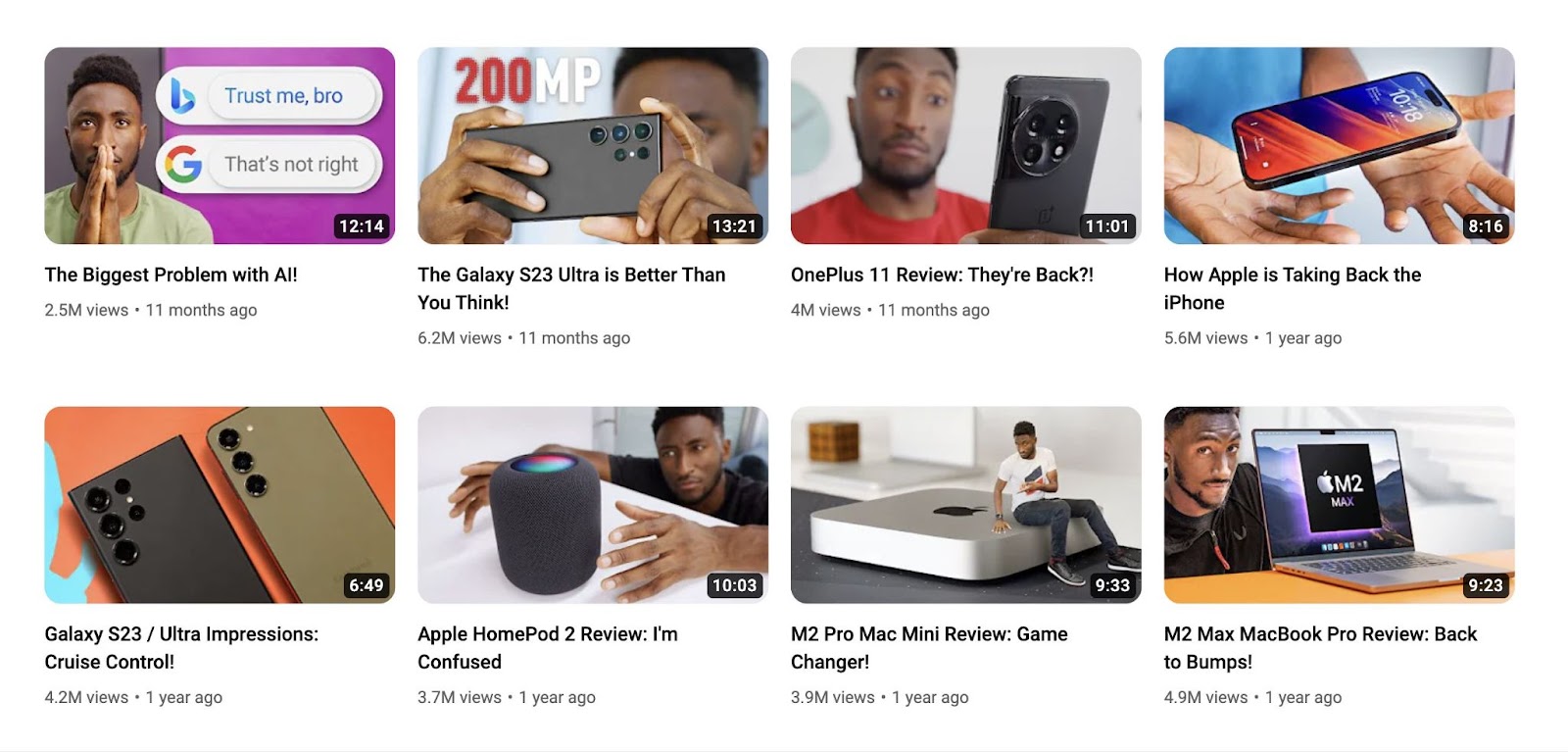
You can also look at thumbnails from top creators in your space to see what works well. Take inspiration from those but give your thumbnails their own spin.
6. Add Time Stamps to Your Videos
Google sometimes shows time stamps as “key moments” under videos displayed in search results.
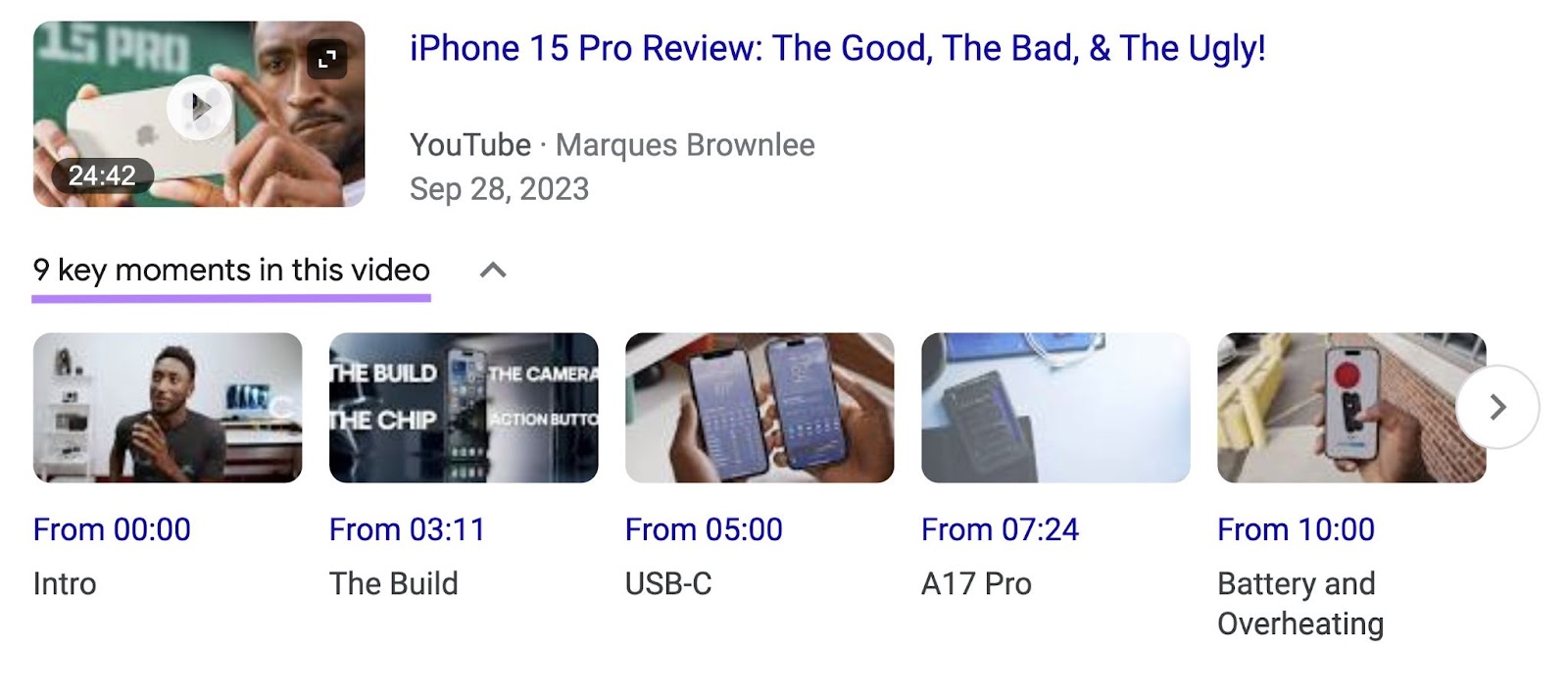
These key moments break your video into digestible sections. Which improves the user experience. Because viewers can easily skip to the parts they find the most relevant.
Here are some best practices to follow when creating time stamps:
- Write the timecode in MM:SS format (minutes:seconds)
- Put the label (a short descriptor) on the same line, separated by a colon or hyphen
- Keep your labels brief—otherwise, Google will truncate them
- Maintain chronological order matching the video flow
Check out the time stamps below from a video about Google Pixel 8 Pro for inspiration.

7. Embed Your Videos in Relevant Webpages
Add your videos to relevant webpages on your site.
That’s what tech news site The Verge often does.
For example, when they published their review of the new iPhone 15 Pro and Pro Max, they embedded their full YouTube video covering the review in the post itself.
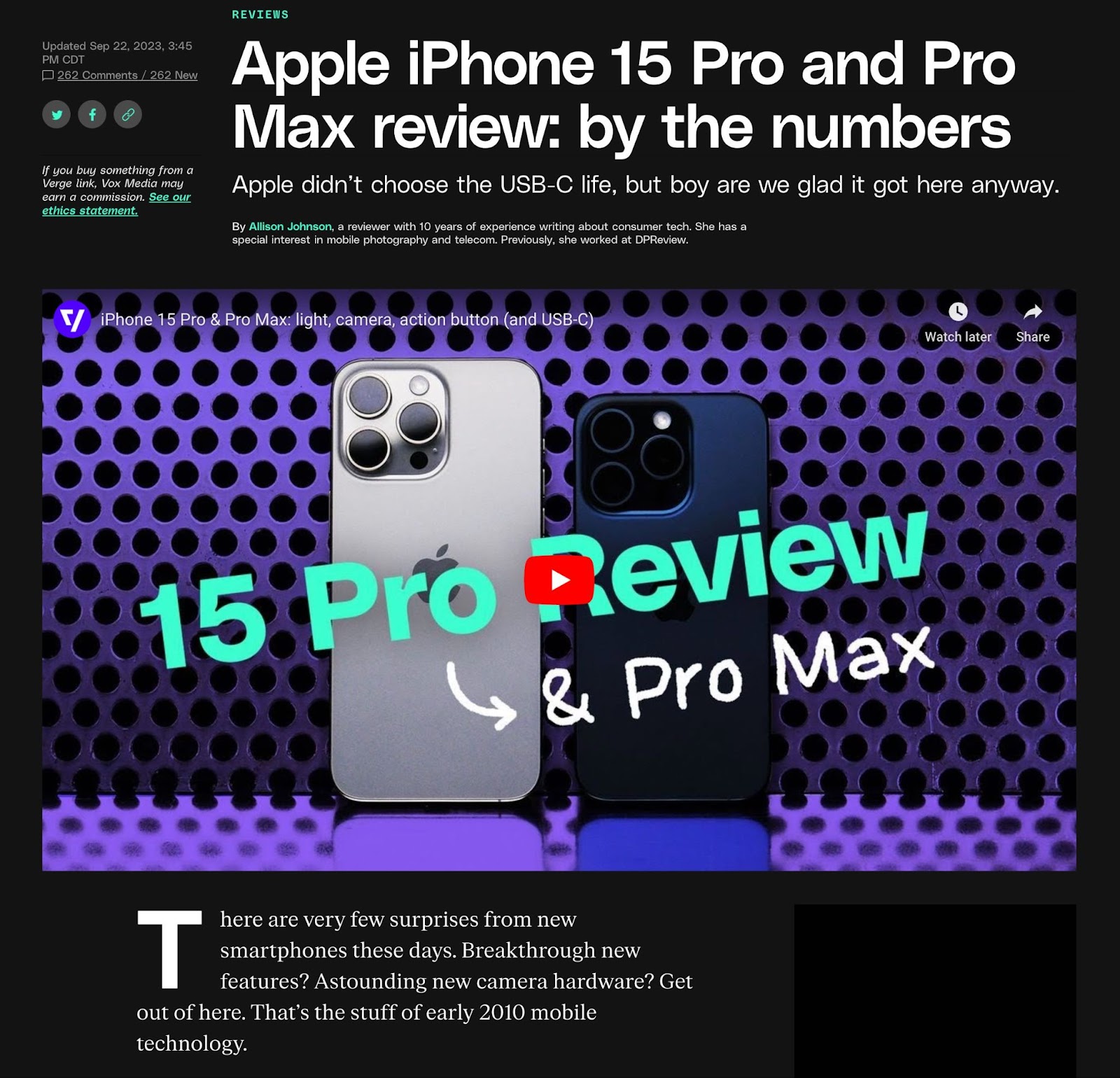
This enables them to have their video content rank in a few ways:
- The original YouTube video can appear in Google search results
- The webpage with the embedded video can also rank in regular Google search results.
When someone clicks on the video-embedded page, they get sent to The Verge’s site—not YouTube.
And that way, users will be able to engage with the video content and their website.
8. Add Schema Markup to Pages with Embedded Videos
If you’re planning to embed videos in your webpages, consider using schema markup. Which is basically a code that gives Google additional context about your content.
Specifically, you can implement the VideoObject schema.
The sample code for that looks like this:
<script type="application/ld+json">
{
"@context": "https://schema.org/",
"@type": "VideoObject",
"name": "Name of the video",
"description": "This is the description of the video",
"thumbnailUrl": "https://example.com/thumbnail.png",
"uploadDate": "2024-01-13",
"duration": "PT1M54S",
}
</script>What does this do?
It hands Google everything it needs to showcase your video in search results. And not just as a plain blue link result.
We're talking about rich results. Meaning your video's title, description, thumbnail, length, and other upload details can all be displayed right in the search results.
Like this:

You might think adding a schema code requires highly technical skills. But you can do this yourself pretty easily.
Check out our dedicated resource on video schema that walks you through the entire process step by step.
9. Build Links to Pages with Videos
Ranking well in Google results can be tough without backlinks.
These are links that point from other websites to your own.
Google may look at these links as votes in your favor—indicators that other sites find your content authoritative, credible, and worth linking to.
And more votes generally mean a higher chance of ranking well.
There are lots of link building strategies out there. Most of these revolve around outreach.
This is when you reach out to other sites in your industry and ask them to link to your video-embedded pages.
But first, you need to find those sites.
Semrush’s Link Building Tool can help.
Follow the setup process to get started.
And you’ll see a list of websites that you can potentially reach out to:
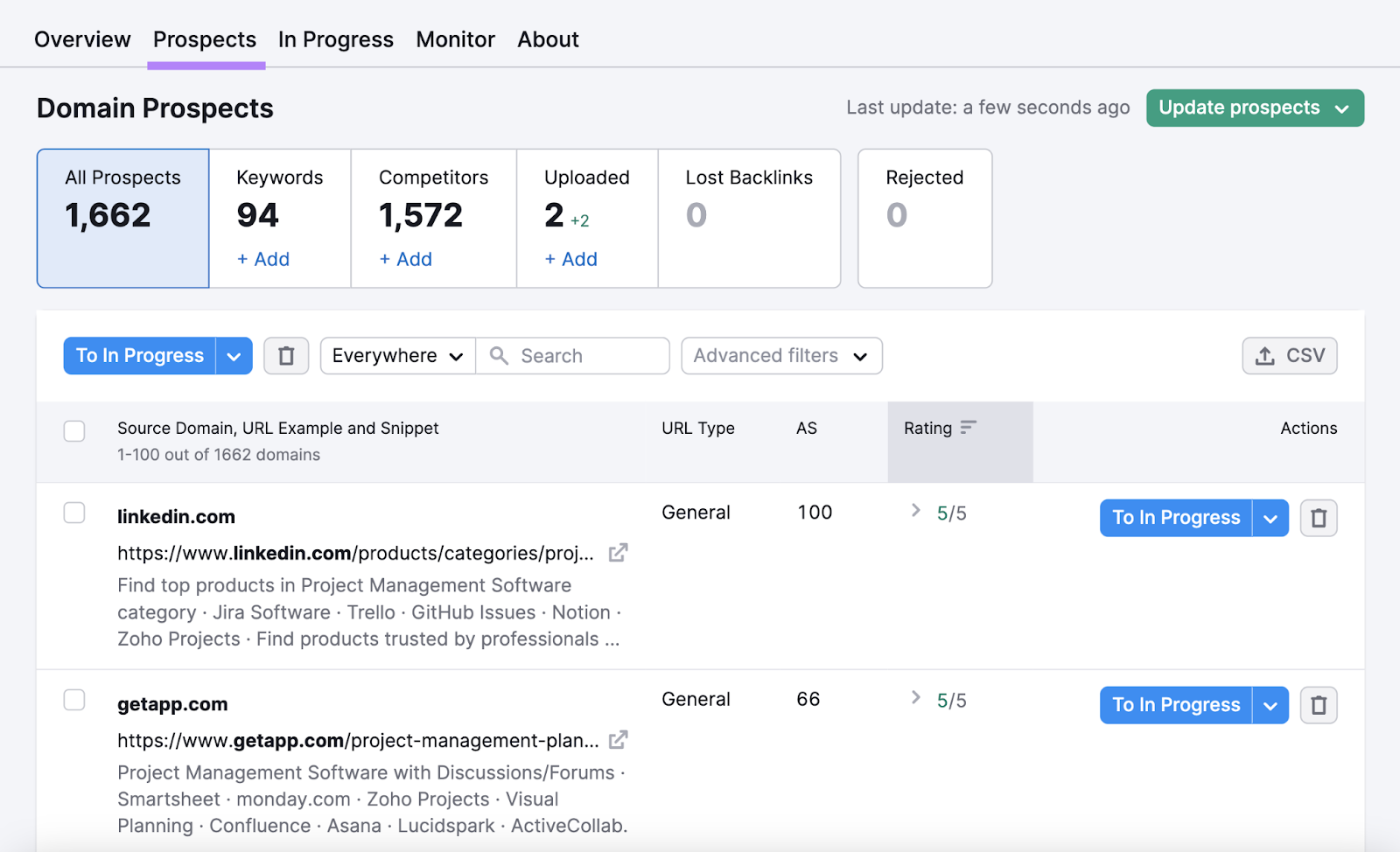
Before you contact them, come up with a solid reason why they should link to you.
Is it because your video provides a fresh perspective on a topic they're passionate about? Or maybe it offers exclusive information not published elsewhere?
Your pitch should clearly highlight the value your content has.
Once you’re ready with your pitch, you can send it within the tool itself.

Start Your Video SEO Journey
That’s what you need to know about video SEO.
Now put all that knowledge into practice:
- Find the best video topics using Semrush’s Keyword Magic Tool
- Optimize them using the best practices shared in this post
- Build links to your pages with videos
Before long, you should see your video content start ranking higher in Google search results.
